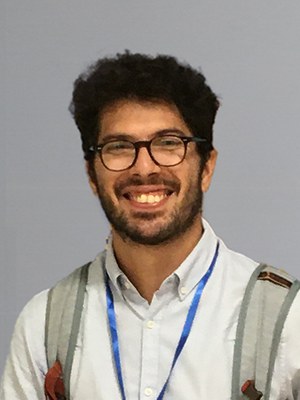Planu Fabio
XXXVIII Cycle IDAUP (A. Y. 2022-2023)
 Curriculum: Architecture
Curriculum: Architecture
Topic: 1.7 Digital transition: product and process in the digital age for the construction industry. | 1.7 Transizione digitale: prodotti e processi nel l'era digitale per il settore edile.
Home Institution: University of Ferrara
Disciplinary sector:08/CEAR-10/A: Drawing.
Main Supervisor: Prof. Arch. Marcello Balzani, DA Unife
Co-Supervisor: Dr. Arch. Ledian Bregasi, Polis University
External expert(s): Dr. Arch. PhD Fabiana Raco, Non-tenured assistant professor (RTDa)
ORCID ID: 0000-0002-6099-1999
SFERA ID: https://sfera.unife.it/cris/rp/rp28252
Concise CV (English version)
Architect, currently a PhD student at the University of Ferrara, he conducts research at the DIAPReM Research Centre and the TekneHub Laboratory, focusing on strategies and solutions involving 3D survey methodologies, processes, and BIM environment representation. He is involved in industrial and international research projects. He was adjunct professor for the course on techniques of representation at the University of Ferrara and has been a teaching assistant in representation courses since 2021. He graduated with honours in architecture in 2020, with a thesis on the regeneration of Taipei City’s riverfront in Taiwan, where he conducted research at the Chinese Culture University. He also attended the University of Applied Science in Stuttgart as part of the Erasmus Project.
Concise CV (Italian version)
Architetto, attualmente dottorando presso l'Università di Ferrara, svolge attività di ricerca presso il Centro DIAPReM e il Laboratorio TekneHub, concentrandosi su strategie e soluzioni che coinvolgono metodologie di rilievo 3D, processi e rappresentazione in ambiente BIM. Partecipa a progetti di ricerca industriali e internazionali. È stato professore a contratto per il corso di tecniche di rappresentazione presso l'Università di Ferrara e dal 2021 svolge attività di assistente alla didattica nei corsi di rappresentazione. Si è laureato con lode in Architettura nel 2020 con una tesi sulla rigenerazione del lungofiume di Taipei City, a Taiwan, dove ha condotto ricerche presso la Chinese Culture University. Ha inoltre frequentato l'Università di Scienze Applicate di Stoccarda nell'ambito del progetto Erasmus.
Research proposal (English version)
Title: Digital Twin and web platforms: from Scan-to-BIM to sensor integration for the development of the digital twin for the monitoring and management of the existing built heritage.
Description: This research explores the field of City Information Modeling (CIM), a methodology designed to digitally represent the physical and functional characteristics of cities. As cities evolve and embrace digital innovation, CIM stands as a frontier for potential development. While Building Information Modeling (BIM) tools are widely used for managing architectural-scale projects, their application at the urban scale remains largely untapped. Urban-scale Digital Twins require more than just the aggregation of individual BIM models; they demand geometric and informational models specifically tailored to interpret the complexities of urban environments. The study addresses the critical need to develop new standards for using BIM tools in urban-scale interventions. It seeks to define methods for applying these tools to support Urban Digital Twins, establish frameworks for balancing representation and information in urban DTs, and advance shared standards for CIM. Additionally, the research aims to create navigation scenarios within digital urban models, enabling stakeholders to explore and simulate urban complexities for informed decision-making and future planning. Key stakeholders include city governments, municipal authorities, and urban planners. These groups are central to managing urban development, enhancing public services, optimizing infrastructure, and ensuring compliance with regulations. By fostering collaboration, the research supports the creation of more efficient, sustainable, and livable cities. The ultimate goal is to design a model for urban regeneration that enables a cross-system analysis of city dynamics, driving innovation in urban management and planning.
Keywords: City Information Modeling (CIM); Building Information Modeling (BIM); Urban Digital Twin; Digital representation; Interoperable platforms
Research proposal (Italian version)
Titolo: Gemello digitale e piattaforme web: dallo Scan-to-BIM all’integrazione dei sensori per lo sviluppo del gemello digitale per il monitoraggio e la gestione del patrimonio costruito esistente.
Descrizione: La ricerca esplora il campo del City Information Modeling (CIM), una metodologia concepita per rappresentare digitalmente le caratteristiche fisiche e funzionali delle città. Con l’evoluzione e la digitalizzazione delle città, il CIM si presenta come una frontiera di sviluppo potenziale. Sebbene gli strumenti di Building Information Modeling (BIM) siano ampiamente utilizzati per la gestione di progetti su scala architettonica, la loro applicazione alla scala urbana rimane in gran parte inesplorata. I Digital Twin su scala urbana richiedono più della semplice aggregazione di modelli BIM individuali; necessitano di modelli geometrici e informativi appositamente concepiti per interpretare le complessità degli ambienti urbani. Lo studio affronta l’urgenza di sviluppare nuovi standard per l’utilizzo degli strumenti BIM negli interventi su scala urbana. Mira a definire metodi per applicare questi strumenti a supporto dei Digital Twin urbani, stabilire quadri metodologici per bilanciare rappresentazione e informazione nei DT urbani e promuovere standard condivisi per il CIM. Inoltre, la ricerca si propone di creare scenari di navigazione all’interno di modelli urbani digitali, consentendo agli stakeholder di esplorare e simulare le complessità urbane per decisioni più informate e pianificazioni future. I principali stakeholder includono governi cittadini, autorità municipali e pianificatori urbani. Questi gruppi sono centrali nella gestione dello sviluppo urbano, nel miglioramento dei servizi pubblici, nell’ottimizzazione delle infrastrutture e nel garantire il rispetto delle normative. La collaborazione promossa dalla ricerca punta a creare città più efficienti, sostenibili e vivibili. L’obiettivo finale è progettare un modello per la rigenerazione urbana che consenta un’analisi trasversale delle dinamiche cittadine, favorendo l’innovazione nella gestione e pianificazione urbana.
Parole chiave: City Information Modeling (CIM); Building Information Modeling (BIM); Gemello digitale urbano; Rappresentazione Digitale; Piattaforme interoperabili
